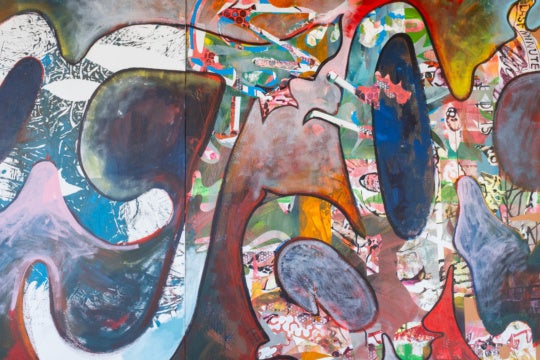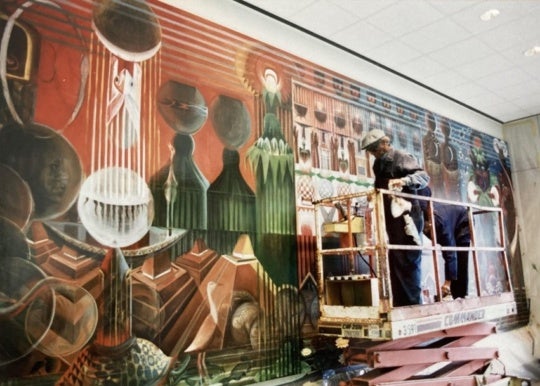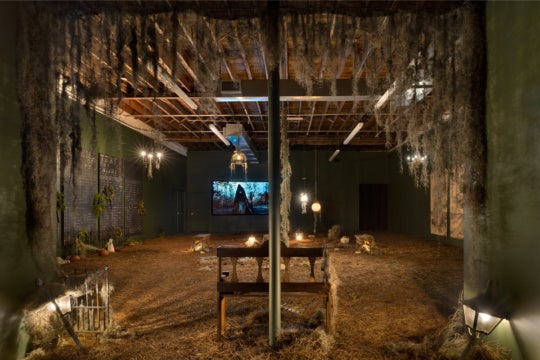
My father was an avid reader of mystery novels, and when I reached adolescence he would lend me his favorite Agatha Christie (mostly the Hercule Poirot stories) and John Dickson Carr, saying, “It’s amazing. You had all the clues right in front of you all along.” After a while, it seemed to me that we didn’t have all the clues; we had a partial version of the tale that omitted something small that the detective saw that we hadn’t been told about until the end of the story. That small something changed everything we readers had been told about, but we couldn’t have known it was there if we worked only from the information we had been given in the beginning.
PushPush Theatre and Film’s experimental production SeeThrough, being presented at Erikson Clock through March 30, operates somewhat the same way—except that we don’t know we are in a mystery story at the beginning, and may not have figured this out after the end, either. There are no murders to solve; the mystery is one found in family life, but that may be the only realization that some viewers come away with.
It is impossible to discuss anything in detail without engaging in the worst of spoilers, so I shall say only that my own perspective was limited in the extreme by my inability to move about without assistance. I suspect that a considerable amount of set-up was being done in the socializing that preceded the performance, because one seemingly pointless element made a great deal of sense in retrospect. Other emotionally charged elements, which seemed like potential McGuffins, ended up seeming more like red herrings.

This may be because the play itself morphed in the process of development, and will continue to do so. The only way to know for sure is to experience the production more than once, and in a different rhythm. The audience begins (after the music and socializing) by wandering through a labyrinth of room installations that may eventually suggest a narrative once viewers encounter a few explanatory placards, which they may or may not see. How much they/we discover depends on how lost or frustrated they/we get, and how much time they/we have to look before they are asked to join in the final communal event, and whether they have read the text on the website, which provided a bit more context than I had on arrival. At least, it mentions that the show has to do with a child, Jenny Rose, staying up past her bedtime to “work out her life questions” “with you, her imaginary friends and a head full of assumptions” and that “each person who enters shifts from an eavesdropping party guest to a puzzle-solving pathfinder to a proactive guest in the story.” This is a start.
The rooms were designed by a number of artists in response to the chief concepts of the original play. Some are more literally illustrative than others; most of them are examples of the current trend towards collecting and arranging vast numbers of trinkets and everyday objects in assemblages in which the sheer accumulation is the point. (We have seen one of these recently at the High Museum in Sarah Sze’s piece, Book of Parts (Centennial), for Fast Forward, and a first cousin to them in Steven Sachs’ installation in the recently closed Elements exhibition at Spruill Art Center.) A few of the rooms are performative; you can’t—or at least shouldn’t—advance until you have accomplished the requested action. A small number of them, designed to accommodate one or two persons at a time, are impossible to experience without causing a hopeless traffic jam in the corridors.

Since we don’t know exactly what it is we are supposed to be looking for, the secrets of this collaborative stage-set unfold in unpredictable order, or fail to unfold at all, depending on whether we pay more attention to art installations than most visitors. If we do pay enough attention, we shall run out of time before we have gotten through everything; if we don’t (since we have been given no clues as to how much attention, or what kind of attention, we ought to be paying), we may be more baffled than we need to be. Even so, by the end of the performance we shall understand more of what we saw—and failed to make sense of—when we first wandered around in the maze, musing and being amused and amazed by turns.
The piece is a true fusion of art and theatre, which means that people who are accustomed to having things accurately labeled will be frustrated at having to figure out who did what based on prior viewings of their work (and enough of the artists start from such parallel aesthetic premises that even then it may not be obvious). Well-known local artmakers disappear into the semi-anonymity that is the customary fate of set designers.
It’s important to note that I arrived with no more information than the description on the invitation, “Celebration • Talk Show • Therapy • Playroom • Labyrinth • Party.” (In fact, I didn’t read any of the prior publicity and came as a guest for reasons unrelated to the performance.) As with the famous experiments with laboratory rats, the greater the amount of previous conditioning and programming the participants have received, the faster will be the navigation through the conceptual maze. By the time of the final performance on March 30, most of the audience members will arrive with considerably more in the way of information and expectation than I had, and their experience will be considerably different.

Apart from the previously mentioned structural problems (e.g., don’t put a potentially plot-driven video in a singularly awkward location), there is no way to discuss SeeThrough in detail without ruining the experience for subsequent audiences. Even the customary reference to characters is impossible when the audience isn’t entirely certain at the beginning whether there will be any characters apart from Jenny Rose. Happenings, one of the several strands of experimental theatre that form distant ancestors to this production, had plot lines but no characterization—so a show that begins with music and audience socializing could go anywhere. Even to reveal that the production involves room installations and topics of family life is setting up more expectations than I had when I arrived, so there is really no way to write about the experience without contaminating it for others.




